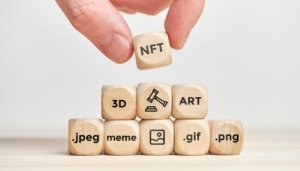The older philanthropic generations like boomers and Gen X get, the more important it becomes for NGOs and charities to take notice of the social benefits of NFTs. Those who are trying to fundraise for social causes realize they have a big problem on their hands as their funding from faithful, lifelong supporters is sadly slowing to a trickle. It’s not just that reliable philanthropic generations are being lost, new generations coming into the donor age bracket like millennials and Gen Z don’t trust legacy fundraising and organizations. It’s not a matter of simply speaking and getting their attention. Nonprofits that want to survive must adapt and change to capture younger generations in a way that’s relatable to them.
 Because so many of the under-40 age group tend to have an anti-establishment mindset, nonprofits are realizing their traditional, analog methods of fundraising through direct mail and institutional credibility will not fly with the demographics they must now capture if they want to survive and continue making social change. No matter how worthy or important the cause, if those with available resources in society are unwilling to participate or donate, the cause will fail. So is there a solution? Believe it or not, there may be one in crypto and NFTs.
Because so many of the under-40 age group tend to have an anti-establishment mindset, nonprofits are realizing their traditional, analog methods of fundraising through direct mail and institutional credibility will not fly with the demographics they must now capture if they want to survive and continue making social change. No matter how worthy or important the cause, if those with available resources in society are unwilling to participate or donate, the cause will fail. So is there a solution? Believe it or not, there may be one in crypto and NFTs.
What’s the deal with NFTs?
 If you don’t know what non-fungible tokens are or the social benefits of NFTs, you may work for a nonprofit. That’s not a dig at nonprofits, it’s just the nature of the gap between the tech generations and institutions hoping to create social change who want to reach them. Here’s a bit about why non-fungible tokens are important.
If you don’t know what non-fungible tokens are or the social benefits of NFTs, you may work for a nonprofit. That’s not a dig at nonprofits, it’s just the nature of the gap between the tech generations and institutions hoping to create social change who want to reach them. Here’s a bit about why non-fungible tokens are important.
Why they’re important
Non-fungible tokens truly have the potential to change the world. Tokenization in general is a rapidly rising technology you can read more about here. Non-fungible means each NFT is unique, unlike a dollar which is interchangeable with any other dollar. Tokens are pieces of data that are recorded transparently and are traceable on a blockchain. It may sound complicated but that’s where the magic comes from.
Coming into public awareness
NFTs have been around for a while, but they really rocketed into the popular culture at the beginning of 2021. In just the span of 12 months, the NFT market shot up from $250 million in value to $41 billion, and the total addressable market is believed to be $1 trillion. An influential founder of crypto technology, Vitalik Buterin, says there are many social benefits of NFTs, but they first need to become “legit as a technology” in people’s minds. They’re more than just .jpgs the kids are trading online like baseball cards. They have real and important utility.
Use cases don’t stop
 There are many use cases for non-fungible tokens that both exist now and have future potential. From tokenizing the art and real estate industries, to transparent voting, to completely user-owned personal, monetizable data, the crypto ecosystem is only now beginning to build out ways to use blockchain and tokenization.
There are many use cases for non-fungible tokens that both exist now and have future potential. From tokenizing the art and real estate industries, to transparent voting, to completely user-owned personal, monetizable data, the crypto ecosystem is only now beginning to build out ways to use blockchain and tokenization.
What NFTs have already done
Non-fungible tokens have already impacted the art world through transparent and immutable provenance. It used to be extremely difficult to prove the history of fine art because physical records are difficult to maintain and track. Tokenization is changing that by making it possible to verify ownership of collectibles with a digital certificate of authenticity. This concept can easily be transferred and applied to use cases in the nonprofit world — among many others. Here are some of the coveted social benefits of NFTs.
Project transparency
One of the growing concerns of people donating to causes is transparency and verifying the impact of their money. While younger generations are hyper-vigilant about this, it’s an intergenerational problem. Supporters want to know the resources they provide are truly and verifiably going to the social change they want to see. Unfortunately, high overhead and low impact ratios in some less-than-ethical charities have made well-meaning donors reluctant to give. Blockchain technology can make transactions and funding extremely transparent.
Accountability
As every nonprofit organization knows, the importance of accountability and reporting cannot be overstated — not only to supporters, but to regulating bodies and internally as well. Tokenizing important data that is traceable on a blockchain can make accountability much easier and reporting almost self-evident. Non-fungible tokens don’t only help with funding either; using NFTs in a similar way that supply chains are beginning to use them can improve the accountability of project results and success by transparently documenting aid or goods, personnel movements, events, or natural resources.
Mutually beneficial fundraising
Selling NFTs as digital art collectibles to fundraise is one of the most obvious ways to use them. And an added way that blockchain improves their fundraising potential is through royalties. Using smart contracts, future revenue can be gained by the NFT creators as a percentage of every resale of the collectible, forever—and it’s automated.
In traditional fundraising models, it’s necessary for donors to give out of a sense of charity, without any tangible benefit. Using non-fungible tokens, both supporters and the receivers of funds are incentivized and rewarded to continue partnering for a cause. For example, NFTs together with AI can provide ongoing and updated interaction for supporters who want to stay involved. And aid recipients, endangered animals, or keepers of natural resources can receive rewards and benefits for participating in the project as well.
NGOs can also monetize physical assets without losing access to them by tokenizating them and selling fractional ownership. DAOs (decentralized autonomous organizations) are also a new way to structure organizations that allow community members to donate and participate in how the organization is governed through governance tokens.
Taking advantage of the social benefits of NFTs
This brief article only touches on the very basic ideas of the social benefits of NFTs and how non-fungible tokens can be used to solve problems for NGOs, bringing fundraising for social change onto the knife’s-edge of technological advancement. By partnering with blockchain developers and users in the crypto and NFT ecosystem, NGOs can take the first step to reaching out to their desired demographics. Learning how to use new technologies to solve existing problems is how the future will be created.
About the Author

Michael Hearne
About Decentral Publishing
Decentral Publishing is dedicated to producing content through our blog, eBooks, and docu-series to help our readers deepen their knowledge of cryptocurrency and related topics. Do you have a fresh perspective or any other topics worth discussing? Keep the conversation going with us online at: Facebook, Twitter, Instagram, and LinkedIn.


